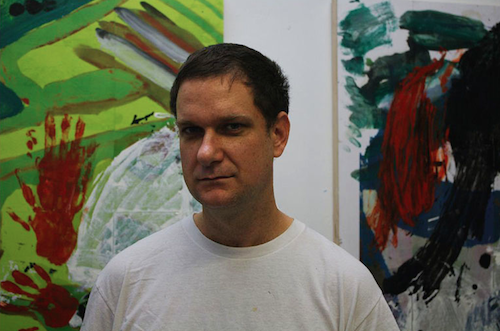
Josh Smith
For those unable to attend painter Josh Smith’s Graduate Art Seminar last month, we’ve got your back. Adam Stamp, who is currently pursuing an MFA through Art Center’s Graduate Art program, has provided an insightful and informed essay about Smith’s irreverent body of work and his wide-ranging talk full of valuable takeaways for emerging young artists.
In January, artist Josh Smith visited Art Center to speak at the Graduate Art Seminar lecture series. Smith is one of the 13 artists featured in The Forever Now, a controversial painting show at MoMA, described by many critics with the rhetoric du jour as the first survey of zombieism,[1] with many considering Smith to be the prime example. The artist who made a name for himself with his “name paintings”, a series of works that continue to this day where he uses his name (literally the letter J-O-S-H S-M-I-T-H) as the subject of his paintings, was described in 2013 by New York Times critic Roberta Smith as “sacrosanct and trashy.” His newest works to make waves depict black palm tree silhouettes in front of Technicolor sky-scapes, á la Edvard Munch.
Smith speaks coolly – deadpan with a slight Tennessee drawl. During his lecture, he shows hundreds of images, spanning a decade of his work: “announcement” paintings, “palette” paintings, collages, skeletons, wasps, ghosts, fish, leaves, monochromes, and, of course, name paintings, which he describes as “gateways to abstraction”. Across Smith’s oeuvre, ostensible sloppiness and nonchalance reign supreme. As a painting appears in his slideshow, he pauses to regard it and say things like: “the thing I like about my paintings so much is how good they look in real life” followed immediately by “it is a mess, it’s the type of thing your family is disappointed when you do stuff like this.”
He feigns disinterest in the workings and politics of the art world and market, but when he shares stories, it’s obvious he possesses acute understanding and awareness. Take his “art fair “ art – bare-bones name paintings for a solo presentation at FIAC: “I think I spent about 15 minutes on it… they filled the booth with it and it was a farce, [but] they’re such awesome paintings.” Then he sends a cardboard box full of works on cardboard to the Venice Biennale. Last year, he decided to present only monochromes at his Chelsea gallery, “I’m not going to blow real brain power on this,” while simultaneously showing sunset paintings and ceramics in Bushwick, giving “a little more to look at” because it’s more of a “train-rider.” Each decision is calculated and directed, specific to the context of its exhibition’s destination.
Josh Smith uses humor and contradiction to distract and deceive. His demeanor, coupled with the insouciance of his work, makes you wonder if this is all some big joke. But amidst all the joshing, Smith reiterates some important themes, paramount to his particular success, but important for all young artists: work hard; don’t do what anyone else wants you to; and make what you want to see. He describes himself as an “exhibitionist”—painting is just a “day job”—with his public persona carefully crafted to support this larger project. He even goes so far as to end his lecture by saying, “I just don’t care.” But no matter how hard he tries to be the preeminent proponent of je m’en foutisme, he can’t help but reveal how sincere and serious he really is. Josh Smith loves what he does: he loves making art, he loves showing art, and he cares a lot.
[1] Zombie Formalism is a term that’s been thrown around in the art world for the last 10 months. Making its first appearance in Walter Robinson’s Artspace essay “Flipping and the Rise of Zombie Formalism,” he describes the current trend in abstract painting as a “walking corpse” reanimating Greenbergian aesthetics to make works that are familiar, easy on the eyes and the intellect and “designer friendly.” A friend of mine has coined the term “one-move” abstraction, which I prefer over zombie, as it speaks more to the pervasive flippancy of this brand of painting. Other terms include: crapstraction, MFA abstraction, neo-modernism, and new casualism.








